June is an important month for Bissell Centre – it’s both Pride Month and National Indigenous History Month. There is a close connection between what Pride Month is all about and Indigenous history in our country.
Countless Indigenous Nations across what’s now called North America saw Two-Spirit Peoples as not only an engrained and normalized part of their culture — Two-Spirit Peoples were often highly regarded and seen as a gift from the Creator.
“They were a very important part of Cree society,” says Elder Ed Lavallee. He is a traditional Plains Nehiyaw (Cree) of the Sturgeon Lake First Nation in Saskatchewan whose career in advocacy for Two-Spirit Peoples has seen him collaborate with groups like Pride Edmonton, the Edmonton Queer History Project, and the Edmonton 2 Spirit Society. Quotes from Elder Ed Lavallee reflect the distinct experience of the Plains Nehiyah Peoples.
“They had many roles in the daily lives of their people and were respected and revered for being Two-Spirited. They were often healers, shamans, mediators in marriage and tribal disputes, keepers of their history and their lore, and taking part and often leading in their social and Spiritual Ceremonies.”
While colonial efforts tried to wipe out any non-conformity from a person’s ascribed gender, the presence of these folks never went away. It wasn’t until 1990 that this way of being was finally given a general English translation to help people across Canada understand that, for countless Indigenous Peoples today, there are far more than only two genders.

The Five Genders
For Indigenous Nations in what’s now called Alberta, there are five genders in the community: male, female, male with female spirit, female with male spirit, and transgender.
“Indigenous people believe that both the female and male spirits reside in the body of a Two-Spirit Individual and the degree of dominance of each spirit ultimately impacts the physical, emotional, mental and spiritual identity of each Two-Spirit person,” says Elder Ed Lavallee.
Rather than trying to change people to better fit with the gender they were born with, Indigenous Nations instead made room for these people and ensured they could contribute to the community with the tasks and skills they identified with most.
Males with female spirits could take on cooking and cleaning duties, were widely seen as gifted artists, and some Nations even saw them adopt orphaned children to take on a caregiver role. Females with male spirits contributed by hunting and being warriors. Some Nations saw females with male spirit folks marrying widowed women.
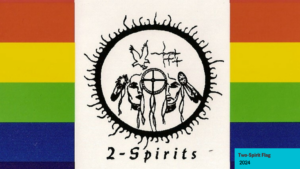
The Reverence for Two Spirit Peoples
In addition to the everyday contributions Two-Spirit Peoples made to their communities, their gift of having two spirits within them also meant they were good healers, medicine people, and visionaries. This is because the two spirits in them give them what’s called double-vision — the ability to see the world through both the male and female lens.
“The belief that Cree Two-Spirit People are special is epitomized in the existence of a powerful Two-Spirit Deity known as Qweskicanskew,” adds Elder Ed Lavallee. “In their spirituality, they believe this Spirit turns things around for the good and well-being of all things on earth. This important Spirit is called upon in prayers for help, protection and blessings.”
Two-Spirit Peoples were foundational to their communities. During colonization, Two-Spirit Peoples’ place in the world seemed to no longer exist. Through the mid- to late-twentieth century, as more Indigenous Peoples began to reclaim their identities, it was clear the different terms used in different Nations like Nádleehí (nad-lay-hee), Winkté (wink-tay), and Niso-acahk-iynew (nee-soh-achak-ee-noo) needed a translation for the wider public to understand.
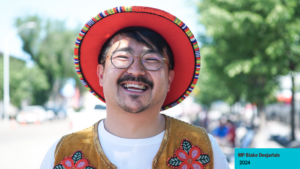
Bringing Two Spirit to the Wider Public
In 1990, at the Third Annual Intertribal Native American, First Nations, Gay and Lesbian American Conference, Elder Myra Laramee put forth the term Two-Spirit. The term is a translation from the Anishnaabemowin (Ojibwe language) term Niizh Manidoowag (neez man-ee-doo-wog). It was added to the front of the Pride acronym (2SLGBTQIA+) in recent years and was even a part of the focus for the Federal 2SLGBTQIA+ Action Plan launched in 2022.
Today, knowledge and understanding about Two-Spirit Peoples is spreading, but is still far behind from where it was before colonization. People like Dr. James Makokis (a Two-Spirit doctor from Kehewin Cree Nation) and MP Blake Desjarlais (a Member of Parliament from Edmonton) are sharing their stories to help more people understand why Two-Spirit Peoples are an essential part of their Nations – and to reduce the stigmatization around people living their authentic lives.
“They are emerging from their long decades of oppression and marginalization working toward re-establishing their rightful roles in their communities as they go through this period of rediscovery,” says Elder Ed Lavalle. “They are working to be recognized, respected and engaged in an integral manner, within Indigenous communities and society in general.”
This Pride Month and National Indigenous History Month, we’re celebrating the bravery of Two-Spirit people coming out and bringing this piece of Indigenous culture to the public forefront. We hope you’ll join us in making room for Peoples who can walk in both worlds to share their gifts and help make this world a more equitable place for everyone.
There’s an old saying that goes, “when you have more than you need, build a longer table.” Boyle Street Community Services and Bissell Centre are coming together to do just that at this year’s Friendship Feast.
This year’s Friendship Feast is on October 9, 2023, at Boyle Plaza (9538 103A Ave). Boyle Street Community Services and Bissell Centre are partnering for two meals to not only fill bellies in the community but also to celebrate the community we serve and appreciate the friendships and love that have grown.
Two Meals – Two Takes on Fall’s Favourite Feast
The first sitting will be from 11:00 a.m. to 2:00 p.m. and will be provided by Boyle Street Community Services. They will be serving up all the traditional Thanksgiving favourites like turkey, stuffing, potatoes; everything you would expect to find when family and friends get together to celebrate. Bissell will serve the second meal from 3:00 p.m. to 6:00 p.m. It will consist of Indigenous delights such as stew and Bannock from our outstanding Food Services team – a meal that’s been met with loud acclaim more than once, including recently at our National Truth and Reconciliation Day Round Dance.
A Friendship Feast Is About Coming Together
Our friends at Boyle Street Community Services recently moved out of their current location and are waiting for their new home, King Thunderbird Centre, to finish construction. We’re helping out by providing some temporary space for Boyle Street Community Service’s programs – so we can continue meeting our community members’ needs.
“This year, we’re not just filling bellies; we’re celebrating our community, appreciating the bonds we’ve forged, and sharing love through two unique meals,” says Director of Marketing and Communications Nivedita Kunjur. “It’s more than a feast; it’s a testament to friendship, unity, and the power of coming together. We’re not just serving food; we’re truly building a longer table.”
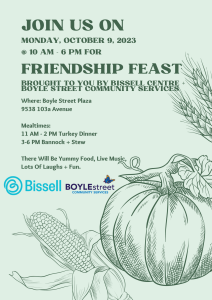
Bissell’s National Indigenous Peoples Day celebration weeks ago brought 96 St. right outside Bissell to life. Bissell Centre has been celebrating National Indigenous Peoples Day, proclaimed in 1996 by the Canadian Government, for well over a decade! This year, it was so much more than a block party– our team made sure this was a celebration to remember.

Keeping Traditions Alive
Our Food Services kitchen team made traditional stew and Bannock for everyone who attended. In total, they served more than 900 meals! Elders from the community held a traditional pipe ceremony to kick things off. They shared stories of struggle and expressed why the customs and traditions they grew up with are so important to folks from Indigenous communities.
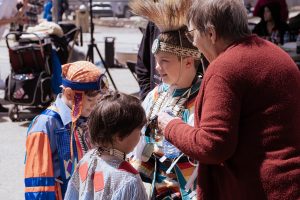
Energetic Local Performances
Families enjoyed the traditional hand games from Indigenous communities. Plus, dance and music performances from the Thunder Lake Singers & Dancers and flutist Theo Waskahat. The block was alive with music, drumming, and dancing for the whole community to enjoy.
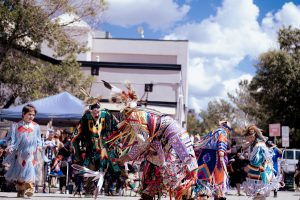
Sharing and Learning Together
National Indigenous Peoples Day is always an amazing celebration, but this year’s was truly one to remember. We’re so happy and grateful for everyone who came out, participated, shared their gifts, and helped make sure Indigenous customs and traditions will stay alive for the people who need them most.
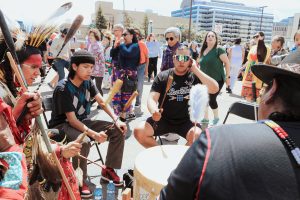
National Indigenous Peoples Day 2023 Photo Highlights
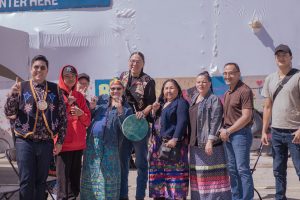
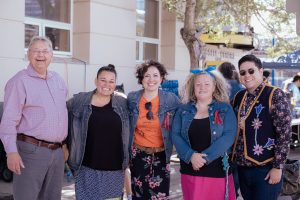
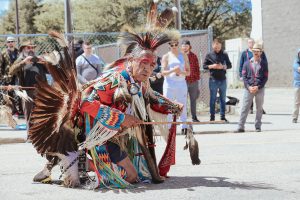



In 2022, Bissell Centre took a long hard look at itself and asked what can be a scary question – what are our 2SLGBTQIA+ team and community members experiencing here? What does Pride at Bissell look like? Are these folks being embraced and celebrated? Are they comfortable being their truest selves here?
41 team members participated in a survey focused on 2SLGBTQIA+ issues – 12 from 2SLGBTQIA+ communities. The results of the survey were promising, and a lot of organizations would take that as a sweeping success and end their efforts there. Instead, we wondered how best to push our organization even further.
Through the results of this survey, summer intern J. Heber looked at the qualitative stats, thought about how they represented the diverse 2SLGBTQIA+ presence at Bissell Centre, and created a fibre art piece to represent that diversity across the organizations.
It is an expression of all the different flags and colours that express the different gender identities and sexual orientations that makeup Pride. Today, it proudly hangs in our Community Space. It stands as a reminder to folks that our diversity is our strength, and inclusion is essential. It also features seeds and the words, “Let’s Grow Together,” demonstrating the seeds of compassion and the thirst for knowledge that helps us all better understand and appreciate one another.
We’re going to let our 2SLGBTQIA+ staff members speak for themselves. Exploring, in their own words, how Bissell Centre is working to improve equity for 2SLGBTQIA+ folks, what their experiences have been like at Bissell, and what Pride month means to them.

Allen
Bissell Centre gives out free rainbow stickers to everyone. I want to point this out first and foremost. It’s the first thing I think about when I think about how Bissell Centre is a safe space.
I joined Bissell Centre in 2020, and I wasn’t sure if I should be open about my gender identity. I saw a lot of staff here be comfortable and open and safe with who they are. Everyone here makes the effort to use my preferred pronouns (he/him) – and anyone who mistakenly uses the wrong pronouns is quick to apologize and correct it. That makes me feel respected and cared for by Bissell Centre.
Especially compared to my home country, Bissell Centre is welcoming to who I truly am. Here, I get to show my Pride without shame or any fear. I get to be open, and that’s important not just for me but for anyone who wants to express their Pride.
Even our community participants treat 2SLGCTQIA+ people with respect and equality. No one ever has anything negative to say about the clothes we choose, how we present, or how we choose to look according to our gender identity. Having this freedom and acceptance is so important for 2SLGBTQIA+ folks and how we can contribute back to our communities.
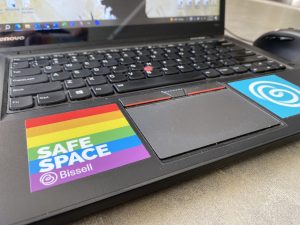
Clinton
When I was placed at Bissell Centre for my social work practicum, I was nervous about entering a new space. Being a member of the 2SLGBTQIA+ community, I am always wary when entering a new space. I don’t know if it’s safe, if I will be harassed or if I can truly be myself.
I remember about a month into my practicum, I mentioned how I noticed there wasn’t really any noticeable visual representation to let new staff and community members know that Bissell is a queer-friendly space. So, we came up with the idea for me to create a 2SLGBTQIA+ resource list for both staff and community members.
Then, I started noticing pride flag stickers placed on doors and laptops. My supervisor told me because I had the courage to identify the gap between Bissell and the queer community, she ordered gender-neutral bathroom signs for the bathrooms in the Community Space. I couldn’t believe that I was a catalyst for these changes. Bissell Centre is not just another group that celebrates pride once a year. They listen to the concerns people have and do what they can to improve.
The community members make Bissell Centre different too. I often get comments that I give off two-spirit energy. I learned that two-spirit folks in Indigenous culture are sacred, which makes me feel honoured. I don’t currently identify as two-spirit – the community members made me curious, and I have since been exploring that side of myself. Because the community members and the staff have created a judgment-free space, it has allowed me to safely be my true self.


















